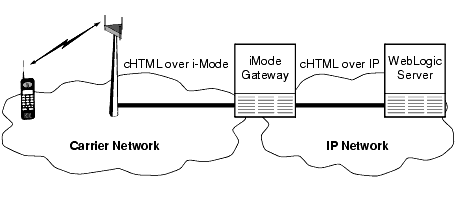Programming WebLogic Server for Wireless Services
|
|
|
Using i-Mode with WebLogic Server
The following sections describe how to provide content suitable for the i-Mode application environment and how to configure and use WebLogic Server with an i-Mode gateway:
Overview
i-Mode is currently a proprietary, closed specification, developed and deployed by NTT DoCoMo of Japan, that allows for the development of Internet and Web-based services for mobile phones and other wireless digital devices. The only i-Mode implementation is DoCoMo's mobile internet access system, although several telecommunication companies in Europe and the United States have expressed an interest in i-Mode.
Note: i-Mode is a trademark and/or service mark owned by NTT DoCoMo.
The i-Mode specification addresses the limitations of wireless networks (low bandwidth, high latency, and unpredictable availability and stability) and wireless devices (limited CPU, memory, and battery life, and a simple user interface). It specifies two essential elements of wireless communication: an over-the-air wireless protocol and a markup language.
i-Mode gateways form the connection between clients on the wireless network and applications hosted on application servers on the Internet. The i-Mode gateway builds a bridge between the telecommunication and computer networks by routing requests from wireless clients to the application servers.
i-Mode Markup Language
i-Mode applications use the compact Hypertext Markup Language (cHTML), which is specifically designed to interface with the microbrowsers in i-Mode-enabled devices. cHTML is a subset of HTML, with a number of extensions for the mobile phone environment. The NTT DoCoMo (English) Supported Tags and Specs defines the tags and structure of a cHTML document.
i-Mode Gateway
As shown in the following figure, the i-Mode gateway acts as the bridge between the wireless network containing wireless clients and the computer network containing application servers.
Figure 3-1 i-Mode Application Architecture
An i-Mode gateway typically includes a protocol gateway, which translates requests from the i-Mode protocol stack to the WWW protocol stack (HTTP and TCP/IP).
When a wireless client sends a request to an i-Mode application running on WebLogic Server, the request is first routed through the i-Mode gateway and then forwarded to the appropriate URL. The response is then re-routed back through the gateway, translated to i-Mode, and forward to the wireless client. This proxy architecture allows application developers to build services that are network and terminal independent.
Additional Resources
Here are some Web sites (organized by category) to visit for additional information about WebLogic Server programming, i-Mode, and cHTML.
